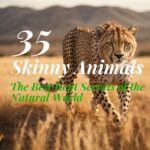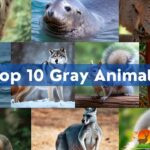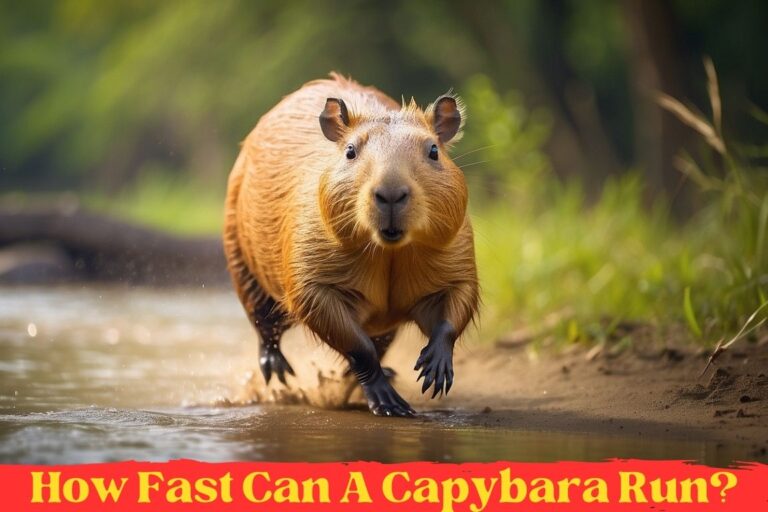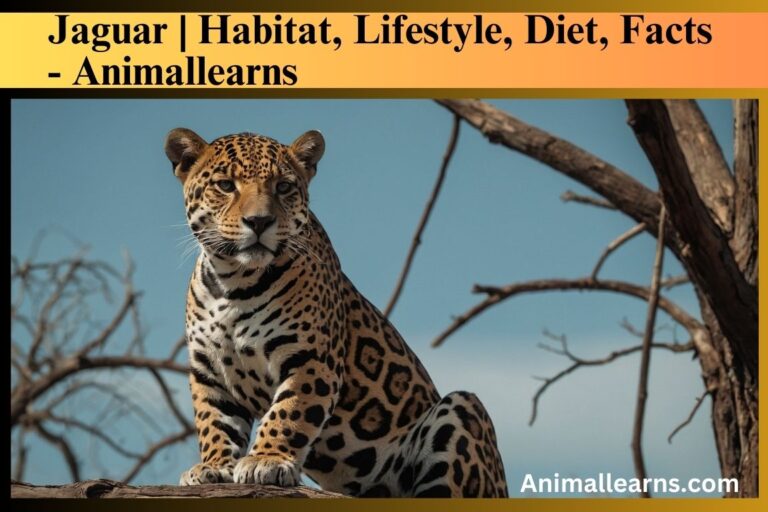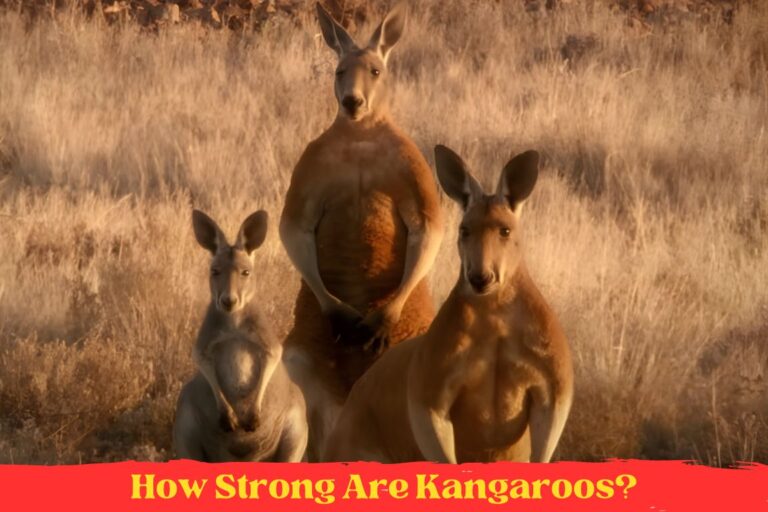Cows Teeth: Do Cows Have Teeth? – Animallearns
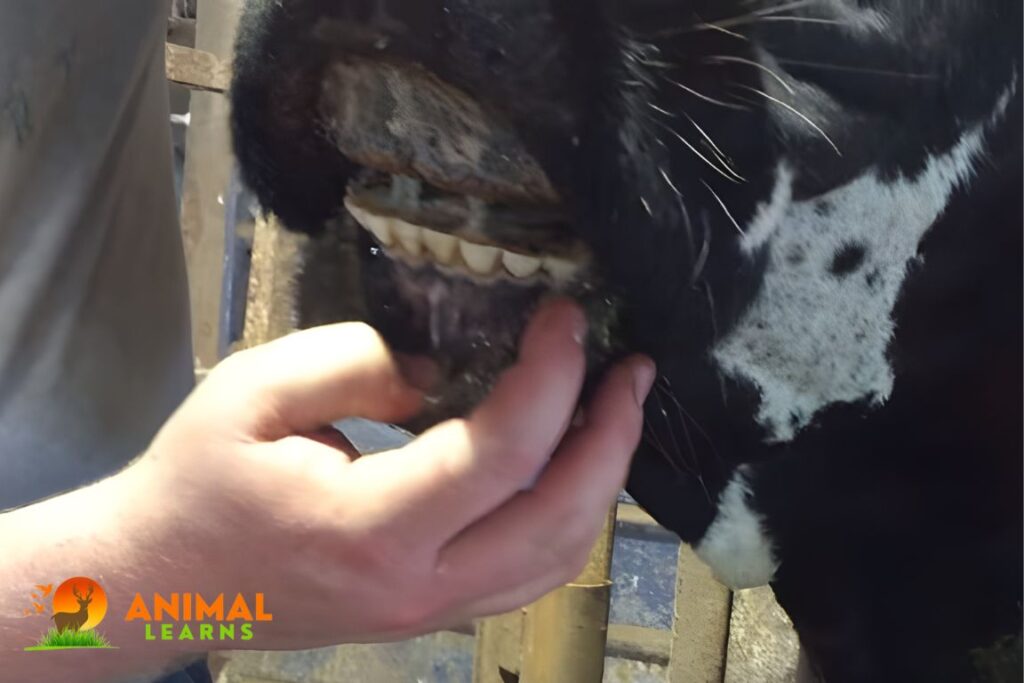
The cows teeth are designed for grazing; they have eight pointed lower incisors that can tear through dense grass and a strong top dental pad. With their cloven hooves, cows are amazing animals from the Bovidae family that have been tamed for almost 10,000 years.
These herbivores are essential to human survival in many ways since they produce milk, meat, and leather. Stemming from 3,000 pounds, some cows may live for decades and thrive in a variety of global ecosystems. In the middle of their massive bulk, one may wonder about their dental makeup.
Cows Teeth
Contents
- 1 Cows Teeth
- 2 How Many Teeth Does A Cow Have?
- 3 Do Cows Have Teeth On The Top?
- 4 Do Cows Have Front Teeth
- 5 Why Do Cows Not Have Front Teeth On The Upper Jaw?
- 6 What Are Cows Teeth Like?
- 7 Determining A Cow’s Age From Teeth
- 8 First Teeth of A Calf
- 9 Cows Teeth Facts
- 10 Can Cows Bite?
- 11 cows teeth diagram
- 12 Cows Teeth Age
- 13 Other Animals That Do Not Have Teeth On The Top Of Their Mouth
- 14 FAQs
Cows have thirty-two teeth, the same as certain other animals, including humans. Their dental arrangement is really different, though. As ruminant animals, cows are different from humans in that they do not have upper incisors.
Like cows, ruminants chew for extended periods of time to help in digestion because they have unique stomachs that allow fermentation. The teeth of cows are an essential part of their digestive system; they are designed to break down fibrous materials, which are important for obtaining nutrients from the large amounts of roughage they eat.
Cows have teeth that are essential for digesting grass for digestion, but they are unable to bite, which highlights the peculiarity of their dental anatomy in relation to other animals.
How Many Teeth Does A Cow Have?
A cow’s adult teeth consist of eight incisors, twelve premolars, and twelve molars. They devour the flora they rely on nearly solely using their teeth. For cows, this is especially crucial because of their four-part stomachs, which need frequent chewing.
A cow uses one of its stomach chambers to partially digest its meal after swallowing it. After that, it vomits this meal, chews it once again, and swallows it once more. This process can occur again; the cow’s ability to break down its food into ever-tinier pieces is essential for proper digestion.
- Incisors: 0 above, and 4 below.
- Premolars: 3 above and 3 below.
- Canines: 0 above and 0 below.
- Molars: 3 above and 3 below.
We must multiply these values by two since the cow dentition arrangement shown above only accounts for one side of the cow’s jaw. This will result in 32 teeth, the full set of cow teeth on both sides.
Do Cows Have Teeth On The Top?

A pair of teeth known as baby teeth is present at birth in cows. When they grow up, permanent teeth will take their place. We refer to this series of teeth as diphyodontia.
The molars and premolars are constantly present, whereas only the incisors undergo change, making the latter two tooth types known as monophyodonts.
It might seem as though a cow’s top jaw is toothless when we peer inside its mouth. Although this is untrue, it makes sense that people might be confused. The upper jaw’s front teeth are absent from cows.
When we observe a cow’s mouth during its chewing process, we can see the lowest eight teeth. These include the so-called pincers and the two middle teeth on the front lower jaw.
The cow retracts its top lip to reveal that its front teeth are missing, along with any pincers. Rather, there is a diastema or space between the two closest teeth.
Despite not being unique to the animal kingdom, this diastema is substantially greater than that of the majority of other creatures.
There are no missing teeth. In order to shield the jawbone beneath, the gum is thicker and firmer than in other areas of the mouth. We call this a dental pad.
Learn more about cows: how many hearts do cows have
Do Cows Have Front Teeth
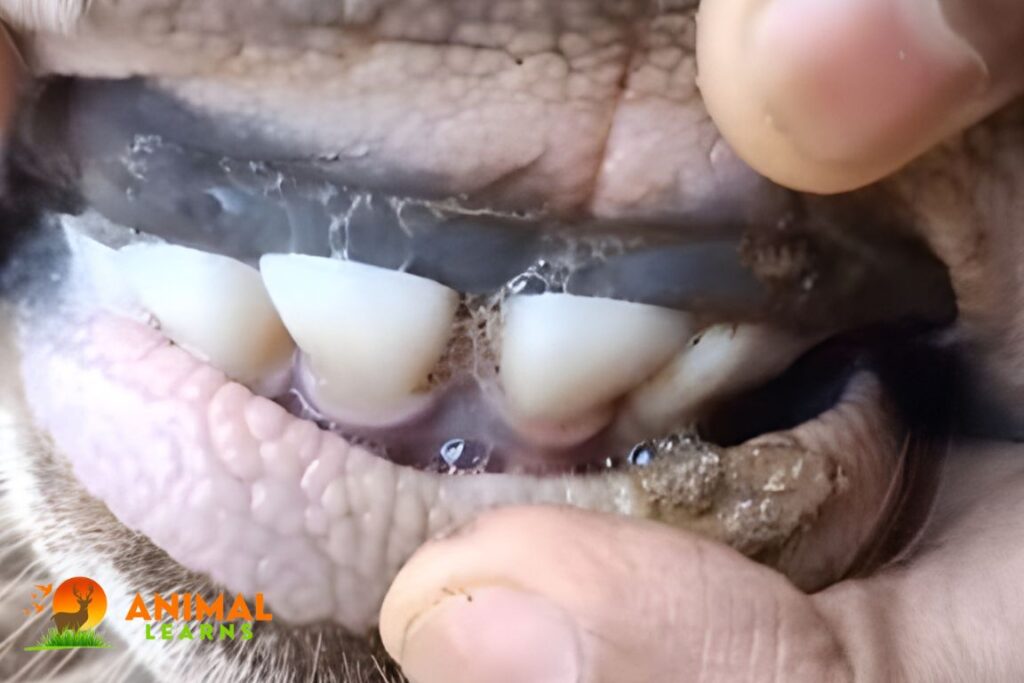
No, the top jaw of cows is missing their front teeth. Rather, they have a dental pad, which is a rough, hard pad. Their lower incisors, or front teeth, operate in tandem with this pad to help them grab and pull off grass.
Why Do Cows Not Have Front Teeth On The Upper Jaw?
As in the lower jaw of cattle, the incisors of other animals would typically be found in the dental pad of a cow. One distinguishing aspect of ruminant species is their dental architecture.
Their food, eating patterns, and digestion are all improved by the loss of upper front teeth and the use of a dental pad. This indicates that cows lack their upper jaw’s front teeth for the following reasons:
Grasping and ripping grass:
Cows mostly eat grasses and other fibrous plant materials. To grab and rip grass, their lower incisors collaborate with their top dental pad.
They don’t bite off clumps of grass as animals with upper front teeth do, but they can pull and rip grass rather well because of their powerful tongue and lower incisors.
Effective mastication:
Since cows are ruminant animals, their stomachs are made up of four sections that are specifically intended to break down tough plant fibers. Cows are able to eat vast amounts of grass without completely cutting it since they do not have upper front teeth.
Exposing the plant material to the cow’s unique stomach compartments during regurgitation and re-chewing stimulates the cows to chew their cud completely and improves digestion.
Grazing adaptation:
Cows have an excellent ability to graze on grasses and other flora. Their grazing activity is suited to their particular oral architecture, which makes it possible for them to graze and digest vast amounts of fibrous plant material with efficiency.
Reduced tooth wear:
The loss of the top front teeth lessens the direct contact between the upper and lower teeth, protecting the dental tissues from deterioration. This may lengthen the cow’s tooth life and lessen the need for ongoing tooth replacement.
Cows have evolved a unique adaptation to match their natural diet, grazing habits, and unique digestive systems throughout time—the lack of upper front teeth. They are well-suited for their position as herbivores in a variety of environments because it enables them to efficiently eat and digest fibrous plant material.
What Are Cows Teeth Like?
Examining the cows teeth formula again will reveal a few oddities. This is because cattle require a specific kind of ruminant food in order to survive, as previously mentioned. Because of this, a cow’s teeth have different qualities:
As ruminant mammals, cows primarily eat plant material, hence they don’t require canines, sometimes referred to as “fangs.” Cattle do not require the ability to rip flesh off their prey, but these teeth enable carnivorous animals to do so.
Yes, cows have molars and premolars, which they use to digest plant material. In order to wear down and break down plant leaves, cows chew sideways rather than with their mouths moving up and down.
One of the fibrous plants that must be passed through the molars several times is lignin, which is rather hard. These teeth have very high crowns with plenty of ridges to prevent wear.
In cattle and veterinary research, teeth play a critical role in determining a cow’s age. Because the incisors are used to determine age, dental chronometry is made feasible. By analyzing the rate at which the incisor teeth erupt, we may even identify the breed.
Determining A Cow’s Age From Teeth
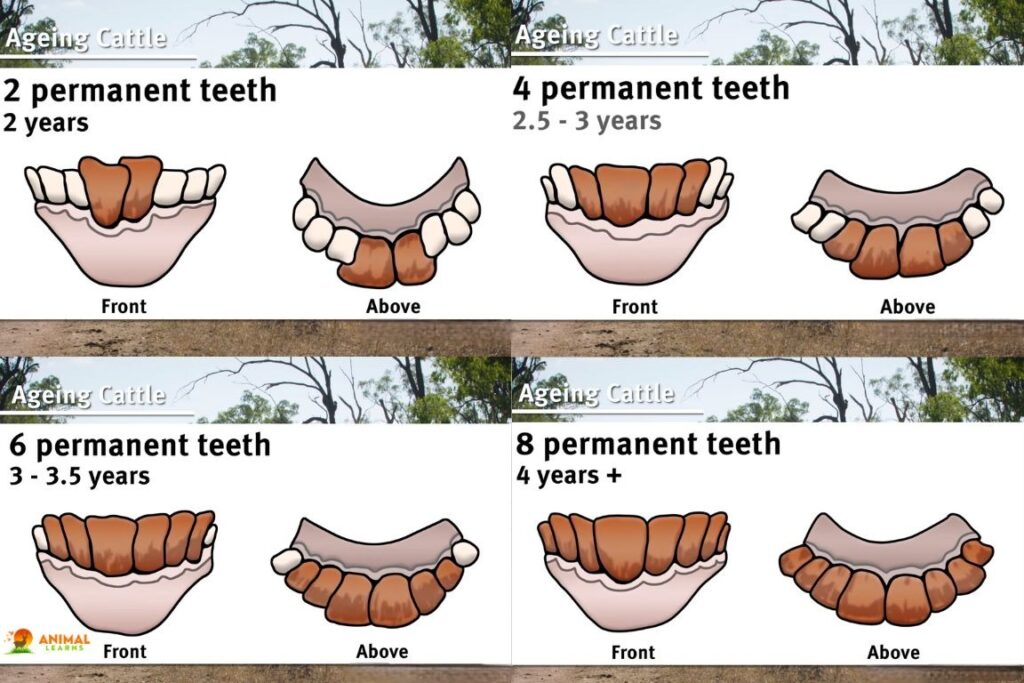
Veterinarians and cow owners may precisely calculate the age of a cow by looking at its front teeth, which sprout in the same sequence every time. The adult teeth are easily distinguished from the baby teeth because they are larger and stronger.
To start, a cow is younger than two years old if it does not have adult teeth. It is between two and three years old in the middle of its mouth contains a single set of adult teeth. The cow is at least three years old if it has two sets of adult incisors or four in total.
They erupt their third set of adult incisors around age four, and by the time they are five years old, they have lost all of their baby teeth.
The teeth of cows do not endure very long. It’s likely that their incisors will be severely worn and they may even be without teeth if they live to be 10 years old. Eating may become challenging or perhaps impossible as a result.
First Teeth of A Calf
After nine months of gestation, calves are born in groups of one or two. Their bottom incisors erupt early in them. There are eight incisors and twelve premolars in each calf’s 20 teeth.
One pair of deciduous (baby) teeth at a time, the permanent teeth begin to erupt as they become older. The first permanent tooth in young cows appears at the age of two.
At that point, the lower middle incisors, sometimes known as pincers, erupt as the first adult teeth. At three years old, the first set of intermediate incisors erupts, placing them on each side of the central incisors.
They erupt their second set of intermediate incisors, and their third set of adult teeth, around age four. Calves receive their last set of incisors, known as corner incisors, at the age of five.
They also obtain their adult cheek teeth at this time, however, they are more difficult to detect and located farther back in the mouth.
Cows Teeth Facts

- Thirty-two teeth are found in cattle. This comprises two canines in the lower front of the jaw and six incisors, or biting teeth.
- The incisor teeth, located in the front of the lower jaw, are used to determine the age of cows. The front bottom row of teeth is what the farmer (or veterinarian) looks at when evaluating the age of cattle. He is specifically searching at the number of teeth, the kind of teeth (permanent or “baby teeth”), the degree of wear on the teeth, and their general appearance.
- Cows lack upper front teeth, which prevents them from biting. They can’t bite you, but they can “gum” you.
- A cow’s teeth exhibit signs of deterioration as she ages. The teeth’s apex will become less pointed and keep wearing down.
- Cattle have baby teeth when they are born. Between the ages of one and a half and two, kids obtain their first set of permanent teeth.
- The three tooth kinds found in cows are incisors, premolars, and molars.
- Although cattle only have incisors in the lower jaw, they do have molars in both the upper and lower jaws.
Can Cows Bite?
Though not in the same manner as humans or many other animals, cows are technically capable of biting. They are not equipped with the top front teeth necessary for actual biting.
A cow’s bulk and hooves serve as its primary defenses. Bulls will pursue threats and have horns as well. Don’t worry, though; the likelihood is that a cow or even a bull bite won’t cause much harm.
cows teeth diagram
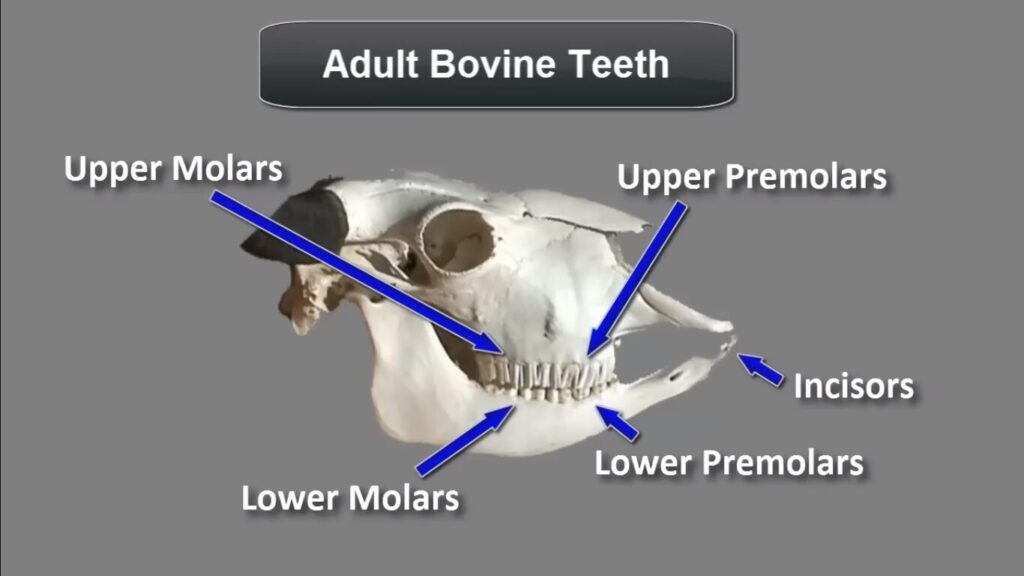
Cows Teeth Age
- 18-24 months: Pinchers: The first pair of permanent incisors erupt on the lower jaw.
- 24-30 months: First intermediate pair: Another pair of permanent incisors erupts next to the pinchers.
- 30-36 months: Second intermediate pair: Another pair of permanent incisors erupts after the first intermediate pair.
- 42-48 months: Corners: The final pair of permanent incisors erupts, completing the set of eight lower incisors.
Other Animals That Do Not Have Teeth On The Top Of Their Mouth
Some species of animals lack teeth on their upper jaw. This is because they have nutritional needs akin to those of cows.
These include other ruminant artiodactyls that do not require the row of top incisors and that also rip up plant stuff. Among these creatures are:
- Sheep: they have eight incisors below, no upper front teeth, and very tiny, undeveloped canines.
- Camel: Camels have two canines on their upper jaw, but no incisors on that area. They utilize their teeth—a total of 34—to defend themselves against other camels.
- Giraffes: Like cows, giraffes mostly have incisors and molars on the bottom of their mouths, but not on the top. Giraffes are an even-toed ungulate mammal, much like cows.
- Anteaters: These insectivores catch ants and termites with their long, sticky tongues. Their strong tongues, which are covered with sticky saliva that draws in and holds onto their meal, dart in and out of termite mounds. It would be unnecessary to have teeth in this particular feeding method.
- Chevrotain: Often called mouse deer, these animals are distinguished by their tiny size. They are neither a kind of deer, despite their name, nor are they a kind of rodent. They feature unusually elongated top canines that protrude from the mouth, lower canines that resemble incisors, and no upper front incisors.
- Llamas: Although they have a unique dentition, llamas also lack upper teeth. They only have incisors in the lower jaw, two tiny canines in the lower jaw, and molars and premolars in both the upper and lower jaws.
- They have two pairs of incisors and two pairs of canines in the upper jaw that have been altered to become teeth in order to fight with one another. In men, they develop at 2-3 years, and in females, at 4-5 years. For their protection, domestic llamas typically have them removed. Check out our post on the distinctions between alpacas and llamas to learn more.
understanding cows teeth, from their unique lack of upper counterparts to their gradual wear and tear with age, paints a fascinating picture of these gentle giants.
These specialized chompers are not just for chewing, but for whispering tales of adaptation, resilience, and the harmonious relationship between cows and their grassy landscapes.
FAQs
Why Do Cows Not Have Top Teeth?
Grazing involves cows ripping grass between their upper jaw’s hard gum pad and their bottom teeth. Top teeth are not necessary!
How Many Teeth Do Cows Have?
32, in line with people! 12 premolars, 12 molars (6 top and bottom each), and 8 lower incisors.
How Often Should You Clean A Cow’s Teeth?
Grazing causes cows’ teeth to naturally erode. There’s no need to clean!
Why Do Cows Have Bottom Teeth?
The bottom teeth efficiently tear and grip grass in conjunction with the top gum pad.
What Is The Life Cycle Of A Cow’s Teeth?
In between 18 and 48 months, permanent incisors emerge. As cows age, their teeth get more worn down and eventually take on a triangular form.



